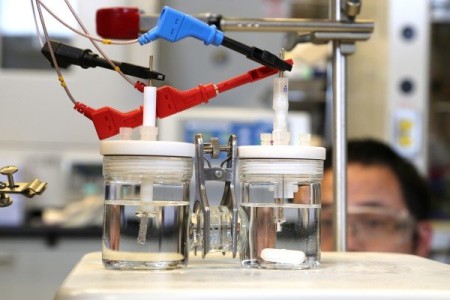Mar
30
An Iron Cobalt Tungsten Efficient Water Splitting Catalyst
March 30, 2016 | 1 Comment

One way to store intermittent sun and wind energy is to use it to split water into oxygen and hydrogen, and then use the hydrogen as fuel. Now scientists at SLAC and the University of Toronto have invented a new type of catalyst that makes this process three times more efficient. In this water-splitting device on the Toronto campus, hydrogen is bubbling up from the left electrode and oxygen is bubbling up from the right one. Image Credit: Marit Mitchell, University of Toronto. Click image for the largest view.
The research published in the journal Science, outlines a potential way to make a future generation of water-splitting catalysts from three abundant metals – iron, cobalt and tungsten – rather than the rare, costly metals such as platinum that many of today’s catalysts rely on.
March of 2016 seems to be the water splitting month.
Aleksandra Vojvodic, a SLAC staff scientist with the SUNCAT Center for Interface Science and Catalysis who led the theoretical side of the work said, “The good things about this catalyst are that it’s easy to make, its production can be very easily scaled up without any super-advanced tools, it’s consistent, and it’s very robust.”
In previous work, Vojvodic and her SUNCAT colleagues had used theory and computation to look at water-splitting oxide catalysts that contain one or two metals and predict ways to make them more active. For this study, Edward H. Sargent, a professor of electrical and computer engineering at the University of Toronto, asked them to look at the effect of adding tungsten – a heavy, dense metal used in light bulb filaments and radiation shielding – to an iron-cobalt catalyst that worked, but not very efficiently.
With the aid of powerful computers at SLAC and elsewhere and state-of-the-art computational tools, the SUNCAT team determined that adding tungsten should dramatically increase the catalyst’s activity – especially if the three metals could be mixed so thoroughly that their atoms were uniformly distributed near the active site of the catalyst, where the reaction takes place, rather than separating into individual clusters as they normally tend to do.
Vojvodic explained, “Tungsten is quite a large atom compared to the other two, and when you add a little bit of it, it expands the atomic lattice, and this affects the reaction not only geometrically but also electronically. We were able to understand, on the atomic scale, why it works, and then that was verified experimentally.”
Using the computational information, Sargent’s team developed a novel way to distribute the three metals uniformly within the catalyst: They dissolved the metals and other ingredients in a solution and then slowly turned the solution into a gel at room temperature, tweaking the process so the metal atoms did not clump together. The gel was then dried into a white powder whose particles were riddled with tiny pores, increasing the surface area where chemicals can attach and react with each other.
In tests, the catalyst was able to generate oxygen gas three times faster, per unit weight, than the previous record-holder, Sargent said, and it also proved to be stable through hundreds of reaction cycles showing no evidence of degradation following more than 500 hours of operation.
Sargent noted, “It’s a big advance, although there’s still more room to improve, and we will need to make catalysts and electrolysis systems even more efficient, cost effective and high intensity in their operation in order to drive down the cost of producing renewable hydrogen fuels to an even more competitive level.”
Looking forward Sargent said the researchers hope to use the same method to develop other three-metal catalysts for splitting water and also for splitting carbon dioxide, a greenhouse gas released by burning fossil fuels, to make renewable fuels and chemical feed stocks. He and five other members of the University of Toronto team have filed for a provisional patent on the technique for preparing the catalyst.
Vojvodic considers the future with, “There are a lot of things we further need to understand. Are there other abundant metals we can test as mixtures in oxides? What are the optimal mixtures of the components? How stable is the catalyst, and how can we scale up its production? It needs to be tested at the device level, really.”
Unaffiliated third party commentator for the press release Jeffrey C. Grossman, a professor of materials science and engineering at MIT, who was not involved in the study, said, “The work impressively highlights the power of tightly coupled computational materials science with advanced experimental techniques, and sets a high bar for such a combined approach. It opens new avenues to speed progress in efficient materials for energy conversion and storage.”
Grossman is right, this caliber of work will have a big impact on materials research, across a very large range of chemistry. For fuels it should be a major competitor in a field filling quickly with great progress.
The only bug is hydrogen storage. But this team realizes, at least peripherally, that recombining fuel elements is likely a step in rapid growth of renewable fuels. Its been a great week for the hydrogen enthusiasts.
Comments
1 Comment so far


For a long time catalysts were improving simply because molecular level manufacturing techniques significantly increased surface area. It is nice to see a true breakthrough improvement. And, this theory suggests that other combinations of metals may improve it even more.
If you can improve electrolysis efficiency enough – you won’t need large batteries to store power.